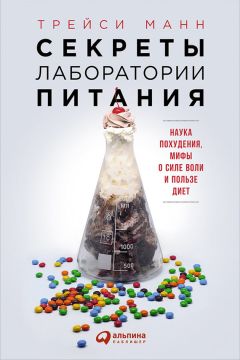247
Jeanne M. Ferrante et al., «Colorectal Cancer Screening among Obese Versus Non-Obese Patients in Primary Care Practices», Cancer Detection and Prevention 30, no. 5 (2006): 459–65; Allison B. Rosen and Eric C. Schneider, «Colorectal Cancer Screening Disparities Related to Obesity and Gender», Journal of General Internal Medicine 19, no. 4 (April 2004): 332–38, doi:10.1111/j.1525–1497.2004.30339.x.
Ostbye et al., «Associations between Obesity and Receipt of Screening Mammography, Papanicolaou Tests, and Influenza Vaccination».
Pascoe and Richman, «Perceived Discrimination and Health».
B. Major, D. Eliezer, and H. Rieck, «The Psychological Weight of Weight Stigma», Social Psychological and Personality Science 3, no. 6 (January 19, 2012): 651–58, doi:10.1177/1948550611434400. См. также: Janet Tomiyama et al., «Associations of Weight Stigma with Cortisol and Oxidative Stress Independent of Adiposity», Health Psychology 33, no. 8 (August 2014): 862–67, doi:10.1037/hea0000107. Другой пример можно найти в работе: Natasha A. Schvey, Rebecca M. Puhl, and Kelly D. Brownell, «The Stress of Stigma: Exploring the Effect of Weight Stigma on Cortisol Reactivity», Psychosomatic Medicine (2014): PSY–0000000000000031.
Puhl and Brownell, «Confronting and Coping with Weight Stigma».
Jenny H. Ledikwe et al., «Dietary Energy Density Is Associated with Energy Intake and Weight Status in US Adults», American Journal of Clinical Nutrition 83, no. 6 (June 2006): 1362–68.
Lawrence de Koning et al., «Sugar-Sweetened and Artificially Sweetened Beverage Consumption and Risk of Type 2 Diabetes in Men», American Journal of Clinical Nutrition 93, no. 6 (June 1, 2011): 1321–27, doi:10.3945/ajcn.110.007922. Koning.
Ankur Vyas et al., «Diet Drink Consumption and the Risk of Cardiovascular Events: A Report from the Women's Health Initiative», Journal of the American College of Cardiology 63, no. 12 (April 1, 2014): A1290, doi:10.1016/S0735-1097(14)61290-0. vyas.
Jotham Suez et al., «Artificial Sweeteners Induce Glucose Intolerance by Altering the Gut Microbiota», Nature (September 17, 2014), doi:10.1038/nature13793. suez.
A. S. Levy and A. W. Heaton, «Weight Control Practices of US Adults Trying to Lose Weight», Annals of Internal Medicine 119, no. 7 Part 2 (1993): 661–66; Edward C. Weiss et al., «Weight-Control Practices among U.S. Adults, 2001–2002», American Journal of Preventive Medicine 31, no. 1 (2006): 18–24.
Lisa L. Ioannides-Demos et al., «Safety of Drug Therapies Used for Weight Loss and Treatment of Obesity», Drug Safety 29, no. 4 (2006): 277–302, doi:10.2165/00002018-200629040-00001.
M. A. Whisman, «Loneliness and the Metabolic Syndrome in a Population-Based Sample of Middle-Aged and Older Adults», Health Psychology 29, no. 5 (2010): 550–54, doi:10.1037/a0020760.
J. Holt-Lunstad, T. B. Smith, and J. B. Layton, «Social Relationships and Mortality Risk: A Meta-Analytic Review», PLoS Med 7, no. 7 (2010): e1000316,doi:10.1371/journal.pmed.1000316.
Сведения взяты из дополнительных материалов к статье. Веб-адреса, по которому можно выйти на эти данные, не существует, но их можно найти в основной статье: Flegal et al., «Association of All-Cause Mortality with Overweight and Obesity Using Standard Body Mass Index Categories».
Исследователям нужно было учитывать как минимум два из трех компонентов СЭС (например, уровни образования и дохода), если судить по работе: P. A. Braveman et al., «Socioeconomic Status in Health Research: One Size Does Not Fit All», JAMA 294, no. 22 (2005): 2879–88, doi:10.1001/jama.294.22.2879.
Это справедливо для белокожих людей, которые никогда не курили. Eric A. Finkelstein et al., «Individual and Aggregate Years-of-Life-Lost Associated with Overweight and Obesity», Obesity 18, no. 2 (February 2010): 333–39, doi:10.1038/oby.2009.253.
Это справедливо для белокожих людей, которые никогда не курили. Eric A. Finkelstein et al., «Individual and Aggregate Years-of-Life-Lost Associated with Overweight and Obesity», Obesity 18, no. 2 (February 2010): 333–39, doi:10.1038/oby.2009.253.
Christenfeld, Phillips, and Glynn, «What's in a Name».
P. Campos et al., «The Epidemiology of Overweight and Obesity: Public Health Crisis or Moral Panic?», International Journal of Epidemiology 35, no. 1 (2006): 55–60, doi:10.1093/ije/dyi254.
Davidoff, «Sponsorship, Authorship, and Accountability».
Olshansky et al., «A Potential Decline in Life Expectancy in the United States in the 21st Century».
W. Wayt Gibbs, «Obesity: An Overblown Epidemic?», Scientific American 292, no. 6 (June 2005): 70–77, doi:10.1038/scientificamerican0605-70.
Olshansky et al., «A Potential Decline in Life Expectancy in the United States in the 21st Century»; David Allison, «Disclosure of Financial Information», New England Journal of Medicine, 2005, http://www.nejm.org/doi/suppl/10.1056/NEJMsr043743/suppl_file/1138sa1.pdf.
Flegal et al., «Association of All-Cause Mortality with Overweight and Obesity Using Standard Body Mass Index Categories».
По просьбе этого человека в книге его имя изменено.
Walter Mischel, «From Good Intentions to Willpower», in «The Psychology of Action: Linking Cognition and Motivation to Behavior», ed. Peter Gollwitzer and John Bargh (New York: Guilford Press, 1996), 197–218.
Об этой стратегии (и о многих других) мы писали в работе, посвященной обзору стратегий самоконтроля: Traci Mann, Denise de Ridder, and Kentaro Fujita, «Self-Regulation of Health Behavior: Social Psychological Approaches to Goal Setting and Goal Striving», Health Psychology 32, no. 5 (May 2013): 487–98, doi:10.1037/a0028533.
Lisa R. Young and Marion Nestle, «The Contribution of Expanding Portion Sizes to the US Obesity Epidemic», American Journal of Public Health 92, no. 2 (February 1, 2002): 246–49.
Lisa R. Young and Marion Nestle, «The Contribution of Expanding Portion Sizes to the US Obesity Epidemic», American Journal of Public Health 92, no. 2 (February 1, 2002): 246–49.
Nancy Rivera, «Ice Cream Firm Turns 40: Baskin-Robbins Starts Program to Revitalize», Los Angeles Times, May 6, 1985.
Young and Nestle, «The Contribution of Expanding Portion Sizes to the US Obesity Epidemic».
Young and Nestle, «The Contribution of Expanding Portion Sizes to the US Obesity Epidemic».
B. Wansink and C. S. Wansink, «The Largest Last Supper: Depictions of Food Portions and Plate Size Increased Over the Millennium», International Journal of Obesity (2005) 34, no. 5 (May 2010): 943–4, doi:10.1038/ijo.2010.37.
B. Wansink and C. S. Wansink, «The Largest Last Supper: Depictions of Food Portions and Plate Size Increased Over the Millennium», International Journal of Obesity (2005) 34, no. 5 (May 2010): 943–4, doi:10.1038/ijo.2010.37.
Сведения обзорного характера можно найти в работе: Brian Wansink, «Environmental Factors That Increase the Food Intake and Consumption Volume of Unknowing Consumers», Annual Review of Nutrition 24 (January 2004): 455–79, doi:10.1146/annurev.nutr.24.012003.132140. См. также: Carmen Piernas and Barry M. Popkin, «Increased Portion Sizes from Energy-Dense Foods Affect Total Energy Intake at Eating Occasions in US Children and Adolescents: Patterns and Trends by Age Group and Sociodemographic Characteristics, 1977–2006», American Journal of Clinical Nutrition 94, no. 5 (November 1, 2011): 1324–32, doi:10.3945/ajcn.110.008466; David A. Levitsky and Trisha Youn, «The More Food Young Adults Are Served, the More They Overeat», Journal of Nutrition 134, no. 10 (October 1, 2004): 2546–49.
Brian Wansink, «Can Package Size Accelerate Usage Volume?», Journal of Marketing 60, no. 3 (1996): 1–14, doi:10.2307/1251838.
Brian Wansink, Koert van Ittersum, and James E. Painter, «Ice Cream Illusions: Bowls, Spoons, and Self-Served Portion Sizes», American Journal of Preventive Medicine 31, no. 3 (2006): 240–43.
Ellen van Kleef, Christos Kavvouris, and Hans C. M. van Trijp, «The Unit Size Effect of Indulgent Food: How Eating Smaller Sized Items Signals Impulsivity and Makes Consumers Eat Less», Psychology & Health 29, no. 9 (September 2014): 1081–1103, doi:10.1080/08870446.2014.909426.
Brian Wansink, James E. Painter, and Jill North, «Bottomless Bowls: Why Visual Cues of Portion Size May Influence Intake», Obesity Research 13, no. 1 (January 2005): 93–100, doi:10.1038/oby.2005.12.
Brian Wansink, James E. Painter, and Jill North, «Bottomless Bowls: Why Visual Cues of Portion Size May Influence Intake», Obesity Research 13, no. 1 (January 2005): 93–100, doi:10.1038/oby.2005.12.
B. Wansink and K. Van Ittersum, «Illusive Consumption Behavior and the DelBoeuf Illusion: Are the Eyes Really Bigger than the Stomach?», Annual Review of Nutrition 24 (2004): 455–79.
Wansink, Painter, and North, «Bottomless Bowls».
Piernas and Popkin, «Increased Portion Sizes from Energy-Dense Foods Affect Total Energy Intake at Eating Occasions in US Children and Adolescents».
Frank McIntyre, «U.S. Companies Shrink Packages as Food Prices Rise», Daily Finance, 2011, http://www.dailyfinance.com/2011/04/04/u-s-companies-shrink-packages-as-food-prices-rise/.
«Saving on Toilet Paper», OccupiedLife.com, 2011, http://occupiedlife.com/saving-on-toilet-paper/; Peggy Wang, «46 Penny-Pinching Ways to Save a Lot of Money This Year,» Buzzfeed.com, 2013, http://www.buzzfeed.com/peggy/46-penny-pinching-ways-to-save-a-lot-of-money-this.
Keith Hawton et al., «Long Term Effect of Reduced Pack Sizes of Paracetamol on Poisoning Deaths and Liver Transplant Activity in England and Wales: Interrupted Time Series Analyses», BMJ (Clinical Research Ed.) 346 (January 2013): f403; K. Hawton, «Effects of Legislation Restricting Pack Sizes of Paracetamol and Salicylate on Self Poisoning in the United Kingdom: Before and After Study», BMJ 322, no. 7296 (May 19, 2001): 1203, doi:10.1136/bmj.322.7296.1203.
Josje Maas et al., «Do Distant Foods Decrease Intake? The Effect of Food Accessibility on Consumption», Psychology & Health 27, Suppl. 2 (October 2012): 59–73, doi:10.1080/08870446.2011.565341. См. также: Gregory J. Privitera and Faris M. Zuraikat, «Proximity of Foods in a Competitive Food Environment Influences Consumption of a Low Calorie and a High Calorie Food», Appetite 76 (May 2014): 175–79, doi:10.1016/j.appet.2014.02.004.
Maas et al., «Do Distant Foods Decrease Intake?».
Paul Rozin et al., «Nudge to Nobesity I: Minor Changes in Accessibility Decrease Food Intake», Judgment and Decision Making 6, no. 4 (2011): 323–32.
Насколько я знаю, никто не проводил подобный эксперимент, поэтому это только предположение.
См., например: Frances Martel, «Jon Stewart Rails Against Bloomberg's 'Draconian' Soda Ban with Piles of Gross 'Legal' Food», Mediaite.com, 2012, http://www.mediaite.com/tv/jon-stewart-rails-against-bloombergs-draconian-soda-ban-with-piles-of-gross-legal-food/.
Cecilia Kang, «Google Crunches Data on Munching in Office», Washington Post, September 1, 2013. См. также: B. Wansink, J. E. Painter, and Y. K. Lee, «The Office Candy Dish: Proximity's Influence on Estimated and Actual Consumption», International Journal of Obesity 30, no. 5 (May 17, 2006): 871–75, doi:10.1038/sj.ijo.0803217; James E. Painter, Brian Wansink, and Julie B. Hieggelke, «How Visibility and Convenience Influence Candy Consumption», Appetite 38, no. 3 (June 2002): 237–38, doi:10.1006/appe.2002.0485.
Carol E. Cornell, Judith Rodin, and Harvey Weingarten, «Stimulus-Induced Eating When Satiated», Physiology & Behavior 45, no. 4 (1989): 695–704.





